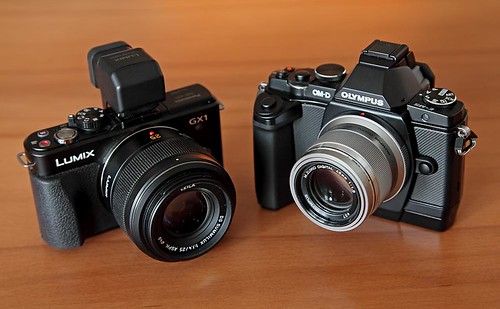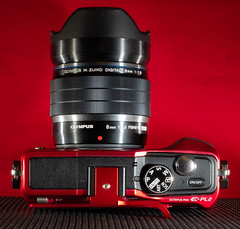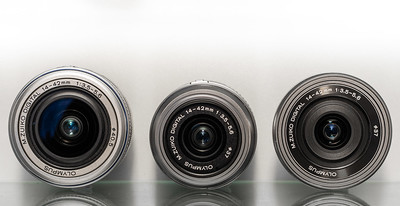Micro Four Thirds

|
| Panasonic Lumix DMC-GX1 w/ EVF add-on, and Olympus OM-D E-M5 image by fotograf@flickr (Image rights) |
Micro Four Thirds (or Micro Four-Thirds, abbreviated MFT or µ4/3) is a photographic system, similar in concept to Olympus' OM system for film photography. The name 'Four-Thirds' derives from the size and format of the image sensor used in the camera bodies. The system was developed by Olympus in partnership with Panasonic.
It was derived from the Four-Thirds system for digital SLRs, but lacks a mirror box, being thus adequate for compact digital system cameras. It has half the focal flange distance and 6mm smaller bayonet throat size.
Four-Thirds is not an open standard; Olympus controls access to the design specifications and no unauthorised third-party companies are able to use the Four-Thirds logo or create supported peripherals for the system.
Contents
Image Sensor
Unlike 35mm film (and therefore most APS-C sized sensors used by other big camera brands such as Nikon, Canon or Pentax) the Four-Thirds system uses a ratio of 4:3 for its image sensor — 35mm film has a ratio of 3:2 (whereby the long edge of the rectangular sensor is either 4/3rds or 3/2 the length of the shorter side). This ratio was inherited from analogue TV standards.
The actual size of the 4/3 sensor — specified by Olympus, and a design constant in the 4/3rds system white paper — is 18 × 13.5mm, with an imaging area of 17.3 × 13.0mm. This gives the image a diagonal length of 21.6mm; the smallest of the common APS-C sensors used has a diagonal of 24.88mm with dimensions of 20.7mm × 13.8 mm.
The diagonal length of the 4/3rds sensor is roughly half that of a 35mm film negative. The Four-Thirds system is often criticised for the small size of its sensor; referral to the diagram to the right will show that the sensor size is only very slightly smaller than the currently most popular entry-level DSLR, the Canon EOS 400D. Unlike the Canon EOS system however, Four-Thirds cameras are forever 'stuck' at this sensor size whereas many EOS system lenses can accommodate sensor sizes up to 35mm (as used on the Canon EOS 5D).
The ratio of the image size, combined with the smaller sensor means that Four-Thirds based DSLRs have a 'crop factor' of exactly 2 — that is to say, a 50mm film lens used on a Four-Thirds body gives the equivalent field of view to a 100mm lens on a 35mm film camera body. The term 'crop factor' is somewhat misleading as the sensor does not crop the image at all — it simply utilises a smaller section of the lens. In essence only the portion of light entering the lens that actually hits the sensor is altered, meaning the field of view is smaller, and thereby effectively doubling the focal length of the lens.
The 'crop factor' does affect the apparent depth of field of the taken image: with the magnification of 2, the DOF is effectively doubled (again, it is important to note that this perceived effect is due to the FOV 'crop'; the same depth of field is present, but you are viewing it at twice the magnification).
It is important to note that neither the light gathering ability of the lens, nor any of its traits are actually affected: a 50mm f2 lens on a 4/3rds body has the same f-stop and depth of field as a 50mm lens on a 35mm camera, but the 4/3rds sensor only records the equivalent field of view of a 100mm lens. As a general rule of thumb the depth of field of a lens is halved as its focal length is doubled (if the aperture remains constant). The end result is therefore that a 4/3rds camera has twice the depth of field as a 35mm camera with a lens covering the same field of view.
Returning to the above example, a 50mm f/2 OM lens used on a 4/3rds digital body is effectively equal to a 35mm camera with a 100mm lens set at f/4.
As a further example of the above, let us compare a 35mm camera and a 4/3rds camera in a given situation:
- 35mm: 100mm lens, f/4, ISO 800, 1/200sec
- 4/3rds: 50mm lens, f/2, ISO 200 1/200sec
Using the same shutter speed, both these cameras would have the same exposure, have the same depth of field, and the same field of view. The smaller sensor size of the 4/3rds allows a lower ISO to be used at the same shutter speed; the doubling of the depth of field allows a two-stop advantage in sensitivity for the same end result.
This allows a photographer to either use a lens at a lower F-stop (for faster shutter speeds) or shoot at a lower ISO (for lower noise in the final image) than would be possible in 35mm or APS-C format. Olympus states this field of view/depth of field effect was a primary consideration in the design of the Four-Thirds system.
Lenses

|
| Lumix G 1:1.7/20 asph. on GF1 Leica DG Summilux 1:1.4/25 asph. on GX1 image by try...error (Image rights) |
The principles outlined above in the design of the 4/3rds sensor also follow into the lens designs for the system: with a crop (or magnification) factor of 2, a telephoto lens for the 4/3rds system with the same field of view that of a lens designed for 35mm can be half the size.
For example, a 150mm lens fitted to a 4/3rds body produces the same field of view (and therefore effectively the same magnification) as a 300mm lens on a 35mm film camera. Not only does this mean 4/3rds lenses can be half the size of their 35mm counterparts, it also means it is much easier and cheaper to produce lenses with good focal length to f-stop ratios.
Most 4/3rds lenses are also telecentric, meaning that no matter what angle the light enters the lens, the glass within the lens is designed to ensure the beams of light hit the sensor straight on. This design requirement is due to the nature of digital sensors: they are highly sensitive to the angle at which light hits them, with highly angled photons not being picked up by the sensor at all.
The lens mount for 4/3rds is roughly twice that of the imaging sensor, again allowing improvements in lens design: with the lens focusing the image down to half the area before it hits the sensor, it allows the lenses to be brighter without sacrificing the size or weight advantages gained by the smaller sensor.
Micro-Four-Thirds autofocus lenses are or were produced by Olympus (M.Zuiko brand), Panasonic (Lumix & Leica brand), Sigma and Yi (Xiaoyi brand). The lenses for the old Four-Thirds DSLRs are adaptable for autofocus use. Information on 4/3rds mount lenses is listed on the Four-Thirds lenses page. Some were even made by Samyang and Tamron.
 
|
| Left: M.Zuiko 8mm 1:1.8 fisheye upon Olympus Pen E-PL2. Right: M.Zuiko 14-42mm 1:3.5-5.6 kit lens, 3 versions. images by CWhatPhotos (Image rights) |
Camera Bodies
 
|
| G1 body and G2 body, both resembling modern AF SLR design images by Paul Bailey (Image rights) |
The first approach to create a camera body for the µ4/3 system was achieved in 2008 by Panasonic. Its G1 and G2 were totally optimized for photographers by means of their nearly ideal modern CSC design for simply still photography, the GH-variants with video capabilities followed. The second approach was Olympus' retro style concept, creating a new, a digital series of Olympus Pen cameras, and another series of digital Olympus OM bodies, just reviving its classical Olympus camera designs as digital camera body designs of today. The last concept was introduced by Yi: A completely touch-screen-controlled modernistic camera.
Originally there were two companies committed to making cameras using the Micro Four-Thirds system: Olympus and Panasonic. Panasonic µ4/3 cameras are marketed under the Lumix brand name, Olympus' cameras as continuation of its E-series. Both companies abandoned their Four-Thirds DSLR system soon in favor of producing their µ4/3-CSC-system.

|
| Olympus OM-D body, resembling classic Olympus MF SLRs image by Thomas Cizauskas (Image rights) |
In 2013, JK Imaging released a Micro Four Thirds camera using their license to release cameras under the Kodak brand. The camera is the Kodak Pixpro S-1. The Kodak Pixpro S-1 system includes three available lenses under the Kodak name brand, though it is also compatible with all other Micro Four Thirds lenses on the market.
In 2017 the Chinese camera maker Yi joined, also with its own approach, i.e. with a camera body that has a user interface mainly based on its touch screen. The Yi M1 features a very small, streamlined body paired with a Micro Four Thirds lens mount.
More recently, the Micro Four Thirds lens mount has also been used by DJI in certain models of their drone-based camera systems. The Blackmagic Pocket Cinema Camera is also produced with a Micro Four Thirds lens mount option. Z-Cam also produces video cameras using the Micro Four Thirds lens mount.
In 2020, Olympus sold its entire camera imaging business to Japan Industrial Partners, Inc (JIP). JIP seems to be willing to continue production of stuff for the Micro Four Thirds camera system previously made by Olympus, and already introduced two system camera models which are improved versions of cameras of the Olympus OM-D series, and even an advanced M.ZUIKO lens. The JIP group company named OM Digital Solutions Corporation makes, represents and improves the surviving Olympus products. Since the end of 2022 it uses its own brand name OM System.
Links
- Micro Four-Thirds pages.
- Fourthirdsphoto - The unofficial community for the system.